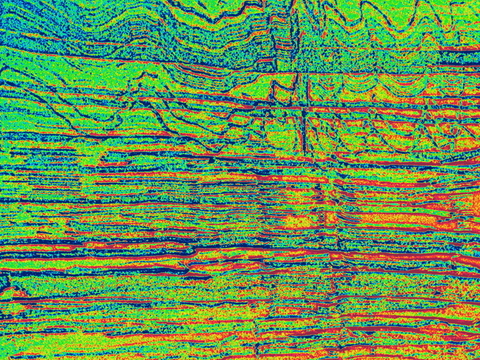DIMENSIONS
Man is a multidimensional being, just as are all phenomenalities in the existential whole. Three dimensions are of objectivity; one dimension is of subjectivity. These are not separate dimensions. The first dimension concerns unity. It correlates with the state of man’s awareness known as deep sleep. This first dimension is the beginning point of all objective manifestation. Here is the totality of potentiality, an apparent absence of objectivity, yet the perfect fullness of what will be. There is only one-ness, primal unity and simplicity existing with no divisions or differentiations. This first dimension involves unity in motion, which could be considered as length, or the line (geometrically).
The second dimension concerns duality. It correlates with the state of dreaming. Homogeneous unity splits itself into the first movement of heterogeneity, the worlds of division, the beginning of the objective formation of the multitudes of polar opposites. The second dimension involves length moving in a bilinear direction, which could be considered as length and width, or the surface (geometrically).
The third dimension concerns multiplicity. It correlates with the state of waking consciousness. This is the dimension of physical matter, where the great complexity of the structures of the universe and all its events exist. The third dimension involves length and width extended in a bilateral direction, which could be considered as length, width, and thickness, or the solid (geometrically).
The fourth dimension is the key to understanding the mystery of existence. It concerns consciousness. Whatever is perceivable is phenomenal, objective, and transient. Anything transient is susceptible to change and conditions, whether in the external world of sense objects or in the internal world of memory and imagination of the mind. Everything within the three dimensions is perceived by consciousness.
The space-time continuum, in which the three dimensions of phenomenal existence are apparent, is not a different dimension outside of these three dimensions, but an aspect of them. Consciousness is not measurable geometrically as are the other three dimensions of materiality.
There are four states of consciousness; waking, dreaming, deep sleep, and the fourth state. The life of multidimensional man moves through the three states, but beyond the three is the fourth state, pure consciousness. These four states of consciousness are essentially correlated and have an interdependent symmetry with the four dimensions of existence. The fourth state is the ground and source of all being and becoming, the beginninglessness and the endlessness of timeless and spaceless existence, and the foundation of the totality of the phenomenal event-matrix in the so-called space-time continuum.
1st Dimension Deep Sleep
2nd Dimension Sleep Dreaming; Waking Dream
3rd Dimension Waking Thought
4th Dimension Waking Lucidity; Knowing Witness
In the waking state, the mind operates and is focused outwardly toward objects of the senses, toward the gross objective realm. This state corresponds to the objective phenomenal world of physical objects. In the dreaming state, the mind operates and is focused inwardly toward its own mental, subtle objective realm. This state corresponds to the world of mental reflections. In the deep sleep state, the mind does not operate; there is a silence with no focus, a state of suspension of sense, thought, and reflection.
The first three states emerge from the fourth, but the fourth does not originate from anything other than itself. It is the self-existent eternal principle which is the secret source essence of everything and everyone. It is the primordial Self, the truth of all being and of all becoming. The first three states of consciousness are all transient, changeable, and are all permutations of the fourth and participate in its nature in varying conditional degrees. With the introversion of consciousness from its permutations back into its original primordial primacy, the obstructive clouds of the mind disperse, leaving the clear sky of free consciousness. With the contraction and confinement of consciousness in mental obscurations of ignorance, the clouds intensify, obstructing the clear vision of reality.
Waking consciousness is the field of experience in the phenomenal objective realm. Yet it is important to note that almost every person is not really awake in their waking state, since most of the time there is a passive absorption in distraction of one sort or another. The nearly incessant invasion of daydream is the main obstruction to lucid perception and it possesses the waking consciousness in a mechanical way. Subconscious levels of emotion, desire, memory, and imagination also impede the potential clarity of the waking state, making one subservient to habitual propensities and mechanical reactive thought processes, emotional impulses, and irrational conduct. Hardly anyone realizes this in its full import, while nearly everyone presumes they are awake, aware, and fully conscious in their waking state. But the real truth is that mechanical, habitual, or reactive activity, whether it is on the physical, emotional, or mental levels, is a state of partial and superficial consciousness.
The most important fundamental realization is when someone realizes that his waking state is far less than real awake awareness. When a person realizes he is fairly “asleep” in the waking state, only then can he begin to move toward a progressive awakening. First there is a periodical remembrance or noticing that daydreaming is occurring, that many activities of body, speech, and mind are merely habitual, that throughout the day there is a lot of mechanical and habitual reactivity, and the mind is easily distracted, focus is scattered, and the mind continues to wander unchecked. The cure for this condition is to willfully expand this core realization to be more attentive to the potential for the mind to wander again into the daydream, and lengthen the periods of this attentiveness and thus shorten the periods of habitual superficial awareness.
This progressive entrance into continual and clear self-conscious waking awareness overcomes the ignorance inherent in conceptual illusion and defeats all confusion supporting entanglement in the unwanted. Without real waking awareness the limitations of mundane existence cannot be overcome and one will continue to be enslaved by the easily distracted mind and subservient to all its insignificant desires, biases, attachments, delusions, habits, and projections, which are all semi-conscious mental activities. When these semi-conscious mental activities dwindle, or cease altogether, then the emotional and physical states become purified also.
The waking state is usually the field for the operations of thought and daydream. Thought, or thinking, is a willful act of reasoned, linear thinking that uses previous ideas accumulated from experience or from previous thinking in order to come to conclusion. The conclusion may be based on fact or on fiction depending on the quality of the thinker’s reasoning capacity. Willed thinking, or intentional thinking is done in a state of active attention. Passive attention, on the other hand, is a state of semi-hypnosis and half-sleep in which the daydream rolls on and on. When neither the waking thought state nor the waking dream state is functioning, then there is the lucid state. The waking lucid state must be based on active attention and willful intention.
The external world is perceived through contact by the sense faculties, but whatever impressions the senses receive and report to perception is always tinctured by and filtered through all the information accumulated by the mind. The mind will always project or add on something of its own to what is being perceived through the senses. Hence, the illusions of the world become dominant. But this is not the real world. By overcoming the projective tendencies of the mind, the real world can be known as it really is and clear waking consciousness will permit knowledge of the truth of actuality.
The dream state is based in desire, which creates attachment. When someone is attached to something, his dreaming can never cease. If dreaming does not end then real awake awareness remains an impossibility and real conscious freedom will remain only potential. The mind has a tendency to complete a cycle of thinking to come to It is easy (and habitual) for the mind to come to errant conclusions because of ignorance, lack of information, lack of evidence, lack of capacity for reason, and wrong inference. Something false may be accepted as true merely as an escape from the anxiety caused by the feeling of incompleteness or unfulfilment. This creates a dream to artificially complete or fulfill some desire. Desire becomes the root of frustration and frustration is the root of tension, then the anxiety is the result of these and becomes dominant.
Ego-based desires are impossible to fulfill because they are always growing and changing, and left unfulfilled these desires provoke a feeling of lingering incompleteness and restless motivations. Attachment to an object attained or to an object sought for creates more frustration. There will be fear of losing the object attained or anxiety over trying to maintain possession of it; an object not yet attained creates the same frustration and obsession with seeking after it. It is possible to temporarily suppress these feelings of frustration and anxiety while in the waking state with tactics of purposeful distraction such as entertainment, but upon entering into the sleeping state the tension again becomes focused and active and a dream display is generated by the proclivities of the mind in order that the tension can be relieved through an illusion of completion, which the dream creates. This occurs from a deep subconscious level so that the tension can be relieved or at least reduced so the central nervous system may rest, unaffected by the irritations of tension. Dreams are involuntary and emerge automatically, not subject to the will.
In the dream state, the senses as instruments of perception are shut off and impressions from the external world are not registered. In the dream state all the perceptual impressions emerge from within, from the world of the conditioned mind, from the level of the subconsciousness. A multitude of anxieties, frustrations, and incomplete situations create the state of dreaming. In the common person, dreaming is so prominent that it invades the waking state almost continuously, unless there is an effort to purposefully focus attention. These purposeful efforts are intermittent throughout the daily waking activities but most of the waking period is otherwise occupied by daydreaming. In the common person, waking consciousness and the dream state have not been separated, so awareness keeps slipping back into the continuum of the subconsciousness, the dream.
Dreaming continues to emerge in the waking state based on memories of the past and ambitious motivations for the future. Living with the projections of dream is to be living outside of reality and inside illusion. Reality exists only in the present moment, while dreams exist in projected time, the past and future. Because of the fact that reality is so much mixed up with inferential projections from the tainted subconscious levels impinging on the mind, there can be no actual and clear encounter with reality.
Daydreaming and other obscure wanderings of the mind are never related to the present moment. Dreams are personal mythology, projections from the desire nature of the ego-identity. The problem is ego and egoic activity is the dream. A dreaming mind encapsulates and binds a person to a world of illusion and builds a barrier to the future; but dreaming can end by living in the present moment where there is a potential for a breakthrough to real awareness.
An efficient meditation technique has to be directed to the elimination of distraction, of which the ego-driven dream is the most prominent. When ego is involved, the mind constantly projects and imagines how to attain desires. Dreaming is not limited to a condition of sleeping, but occurs regularly in the waking state also, and when noticed in the waking state, then a meditation technique can be used. When it is clearly seen that nearly the whole day is permeated by the influence of automated tendencies in thinking, speaking, and acting then there will be no doubt that the mind is in a state of nearly continual projection and imagining. Becoming more and more aware of what is really occurring in the present moment allows the subconscious impressions and patterns of the mind to arise into the conscious layers of waking awareness again. As soon as one becomes aware of dreams in both the waking state and in the sleeping state, dreams lose their binding power and one experiences freedom.
Deep dreamless sleep is a state of unconsciousness. In waking consciousness one is always conscious of something, or about something, so consciousness is then based in objectivity. Something will be needed to be focused upon, whether it is an external object or an internal mental object, as in a dream. If there is nothing for consciousness to focus upon, consciousness will suddenly then cease motion and become unconsciousness. This means that consciousness cannot be sustained without its being related to some objective referent. This dreamless sleep is a state where mental functions are absent; there is here no thought, no thinking, no images, no whisper of a dream. In deep sleep the mind processes are temporarily suspended. Those who have had deep meditative experience have said that deep dreamless sleep is nearly the same as samadhi, except for one difference, that in the trance of samadhi one is aware of his awareness although it does not move in the operations of mind or dream, while in deep sleep one is in motionless awareness but is not conscious of the fact.
This state of deep sleep correlates with the first dimension, that of unity. There is only consciousness with no divisions, no processes, and no objectification. Deep sleep and samadhi are very much alike: in deep sleep the ego is suspended and does not create mind or dream activities; in samadhi the ego is also suspended and the practitioner is aware of the fact of his true identity.
With the waking state the ego-notion is dominant. In the dreaming state the ego is there but more hidden in the imagery. Deep sleep is a deep ocean of motionless silence, but one is not aware of it. In deep sleep there is an absence of multiplicity, an absence of duality; pure Being is the one thing there, but one is not aware of it because Being is the one thing that is not an object. When deep sleep can be entered in total awareness, then one has entered his true Being and is existential within the cosmic wholeness. The deep sleep state then is no longer a state of sleep, but a state of waking-lucidity.
Moving more and more toward the innermost center of Being, one realizes that the three states are functional aspects of the Fourth State. This Fourth is the knowing witness consciousness. The Pure Consciousness from which all starts and to which all must return. The Fourth is an eternal continuum, beyond all temporality, beyond conceptual notions related to space, time, or suppositions of causality. The Fourth is the basis of all existence, and can be found in deep introspection, here and now, not related to the linear movements of time, past or future. The present moment is not related to conceptual time; it belongs to the actuality of the eternal. In the fourth there are no distinctions of location, no characteristic identity, no edges, no boundaries. The fourth dimension and the fourth state of consciousness are the same; they are not two. The fourth is not a goal to be sought after or something to be achieved or attained, because it is already present. True Being is always unchanging and unchanged, undivided, nondual, and without any composite parts; it is itself only, absolutely and immutably one only, the essence of all that can be known. Realization of this center of innermost contentment requires a complete transformation of perceptual perspective, freedom from grasping at the past and expectations for the future, and maintaining a stable focus in the truth of the present moment.
Pure consciousness is the ultimate simplicity. It has always been presently available to those who can learn to re-identify with it. The first dimension, the first state of consciousness is pure simplicity, but so simplistic that it is, objectively, non-awareness. The fourth is the very same simplicity, but it is complete and totalistic awareness, the eternal dimension. To be limited and bounded by the other three states is to be confined in the relative objective world; to escape this confinement and enter into the eternal requires entering into the present moment, beyond conceptual time constructs. Presence is the only constant, the only continuum, the only changeless reality, and to become aware of it, as it, is to realize one’s own inner truth as the same as the truth of the whole existence.
The great mystery of our human existence is inferred by the presence of deep sleep. In deep sleep we are ignorant of the real state of our consciousness. Upon awakening from sleep we do not remember what occurred during deep sleep. There is a gap in our memory. Perhaps nothing occurred; just a period of unconsciousness. Perhaps something occurred, but whatever it was did not register in the memory. Either way, there is a gap, a vacancy in the continuity of consciousness. Consciousness seems to be there and then not be there. It is a great mystery, one to be solved by attaining continuity of consciousness. When the fourth is attained, then there is awareness that is continuous, and deep sleep no longer is that vacant time of unconsciousness. The ancient goal of immortality is just this gaining of permanent continuity of consciousness.
© S. R. Allen




